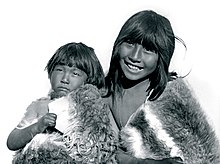
Back شعب السالكنام Arabic شعب السالكنام ARZ Selk'nam BAR Селькнамы Byelorussian Она Bulgarian Selknam Catalan Selk’nam German Selknamoj Esperanto Selknam Spanish Selknam Basque
You can help expand this article with text translated from the corresponding article in Spanish. (October 2024) Click [show] for important translation instructions.
|
 Selk'nam children, 1898 | |
| Total population | |
|---|---|
| 2,761 (Argentina, 2010 est.)[1] 1,144 (Chile, 2017)[2] | |
| Regions with significant populations | |
| Argentina and Chile (294 in Tierra del Fuego). At least 11 live in United States | |
| Languages | |
| Spanish, formerly Selk'nam (Ona), One speaker in Chile.[3] | |
| Religion | |
| Animism, Christianity | |
| Related ethnic groups | |
| Haush, Tehuelche, Teushen |
The Selk'nam, also known as the Onawo or Ona people,[note 1] are an indigenous people in the Patagonian region of southern Argentina and Chile, including the Tierra del Fuego islands. They were one of the last native groups in South America to be encountered by migrant Europeans in the late 19th century.
Settlement, gold mining and farming in the region of Tierra del Fuego were followed by the Selk'nam genocide.[6] In the mid-19th century, there were about 4,000 Selk'nam; in 1916 Charles W. Furlong estimated there were about 800 Selk'nam living in Tierra del Fuego;[7][8] with Walter Gardini stating that by 1919 there were 279, and by 1930 just over 100.[9][10]
In the 2017 Chilean census 1,144 people declared themselves to be Selk'nam.[11] However, until 2020, they were considered extinct as a people by the government in Chile, and much of the English language literature.[12]
While the Selk'nam are closely associated with living in the northeastern area of Tierra del Fuego archipelago,[13] they are believed to have originated as a people on the mainland. Thousands of years ago, they migrated by canoe across the Strait of Magellan.[14] Their territory in the early Holocene probably ranged as far as the Cerro Benítez area of the Cerro Toro mountain range in Chile.[15]
- ^ "Censo Nacional de Población, Hogares y Viviendas 2010: Resultados definitivos: Serie B No 2: Tomo 1" [National Census of Population, Households and Housing 2010: Final results: Series B No. 2: Volume 1] (PDF) (in Spanish). INDEC. p. 281. Archived from the original (PDF) on 8 December 2015. Retrieved 5 December 2015.
- ^ "Estudio confirma al pueblo Selk'nam como etnia viva y facilita su reconocimiento legal" [Study confirms the Selk'nam people as a living ethnic group and facilitates their legal recognition]. El Mostrador (in Spanish). 6 June 2022. Archived from the original on 17 February 2023. Retrieved 10 February 2022.
- ^ Thurman, Judith (23 March 2015). "A loss for words: Can a dying language be saved?". The New Yorker. Condé Nast. Archived from the original on 14 August 2023. Retrieved 15 October 2022.
- ^ Bridges, E. Lucas (1948). Uttermost Part of the Earth (2022 ed.). Echo Point Books & Media, LLC. p. 62. ISBN 978-1648372810.
- ^ Furlong 1917, p. 181.
- ^ Gigoux 2022, pp. 1–2.
- ^ Furlong 1917, p. 175.
- ^ Olivares et al. 2023b, p. 55.
- ^ Gardini, Walter (1984). "Restoring the Honour of an Indian Tribe-Rescate de una tribu". Anthropos. 79 (4/6): 645–647. JSTOR 40461884.
- ^ Chapman 2010, p. ?.
- ^ Cite error: The named reference
Pulitzerwas invoked but never defined (see the help page). - ^ Gigoux 2022, p. 2.
- ^ Anitei, Stefan (11 March 2008). "The Enigma of the Natives of Tierra del Fuego – Are Alacaluf and Yahgan the last Native Black Americans?". Softpedia. Archived from the original on 27 April 2023.
- ^ Hodge, Frederick Webb (December 1915), Proceedings: Held at Washington, December 27–31, 1915, Harvard University, 649 pages
- ^ Hogan, C. Michael (2008). Burnham, A. (ed.). "Cueva del Milodon - Cave or Rock Shelter in Chile". The Megalithic Portal. Archived from the original on 13 August 2023.
Cite error: There are <ref group=note> tags on this page, but the references will not show without a {{reflist|group=note}} template (see the help page).